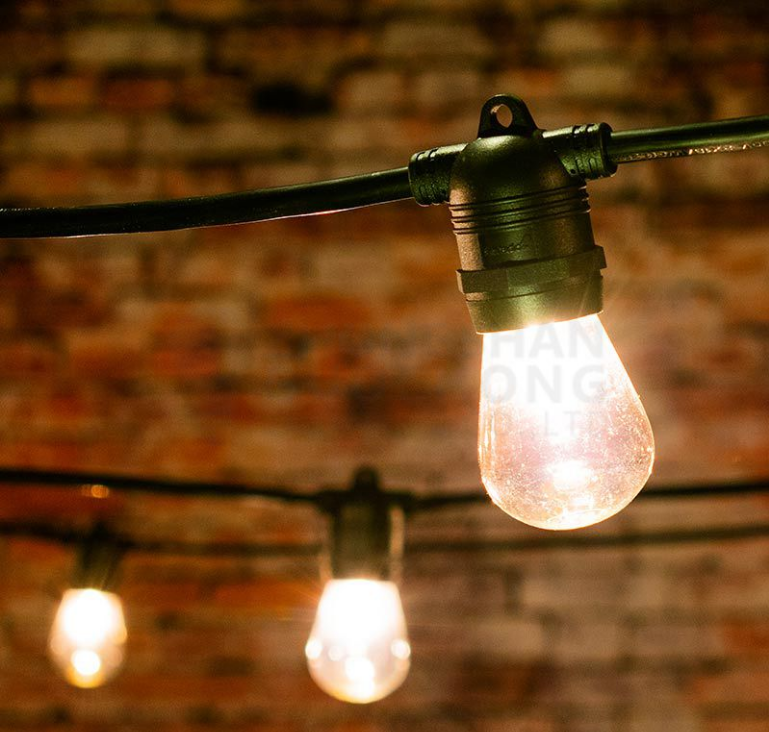May. 18, 2023
Low voltage string lights are a type of decorative lighting that operates at a lower voltage than standard household lighting. They are typically used for ambiance and to add a cozy or festive atmosphere to indoor or outdoor spaces.

Our low voltage weatherproof outdoor string lights are commercial grade and suitable for both indoor and outdoor use. Insulation protects the strands from hot winters, sun, wind, rain, snow and moisture. The flexible, heavy-duty power cord withstands the wear and tear of indoor and outdoor use. Waterproof and shatterproof, with a fully sealed socket, the hanging string lights can be used in sun, rain.
Here are some key points about low voltage string lights you need to know:
1. Voltage: Low voltage string lights typically operate at 12 volts (V) or 24V, which is significantly lower than the standard 120V used in household lighting. The lower voltage makes them safer to handle and reduces the risk of electric shock.
2. Power source: Low voltage string lights usually require a transformer or power adapter to convert the voltage from the standard household outlet to the lower voltage they operate on. The transformer plugs into the outlet and powers the string lights through a low voltage cable.
3. LED technology: Most low voltage string lights use LED (Light-Emitting Diode) bulbs. LED lights are energy-efficient, have a longer lifespan, and produce less heat compared to traditional incandescent bulbs. LED string lights come in various colors, and some models offer programmable features like color-changing or remote control options.
4. Indoor and outdoor use: Low voltage string lights are versatile and can be used both indoors and outdoors. Outdoor models are designed to withstand weather conditions and may have weatherproof or waterproof ratings. Indoor models are often used for decorating rooms, parties, weddings, or holiday displays.
5. Length and configuration: Low voltage string lights come in various lengths and configurations to suit different purposes and spaces. They can be found in different string lengths, such as 10 feet, 25 feet, 50 feet, or longer. Some models have multiple strands connected together, while others have individual bulbs spaced along a single string.
6. Safety considerations: Although low voltage string lights are safer than their high-voltage counterparts, it's still important to follow safety guidelines. Make sure to read and follow the manufacturer's instructions, avoid overloading electrical circuits, and keep the lights away from flammable materials. Additionally, when using outdoor low voltage string lights, ensure the power source and connectors are adequately protected from moisture.
Overall, low voltage lights offer a flexible and safer option for adding decorative lighting to various spaces. They come in different styles and configurations, allowing you to create a charming and cozy atmosphere indoors or enhance the ambiance of outdoor settings.
Installing low voltage string lights over a pool can create a beautiful and enchanting atmosphere for evening gatherings or parties. However, safety should be a top priority when working with electricity near water. Here are some guidelines to consider when installing low voltage string lights over a pool:
Use Waterproof or Weatherproof Lights:
Ensure that the string lights you choose are specifically designed for outdoor use and can withstand exposure to water. Look for lights with an IP65 or higher rating to ensure they are adequately protected against moisture.
Select Low Voltage Lights:
Opt for low voltage string lights that operate at 12 volts or less. This reduces the risk of electric shock and minimizes potential hazards. Low voltage systems are safer around water than standard 120-volt household currents.
Install Ground Fault Circuit Interrupter (GFCI) Protection:
A GFCI is a safety device that can detect electrical imbalances and shut off power to the circuit if a ground fault occurs. It is essential to have GFCI protection for the lights to prevent electrical accidents near the pool.
Consult an Electrician:
If you're unsure about the electrical requirements or feel uncomfortable handling the installation, it's recommended to consult a licensed electrician. They can ensure the lights are installed correctly and safely, following local electrical codes and regulations.
Maintain Proper Distance:
String lights should be hung high enough to prevent accidental contact with the pool water. Maintain a safe distance between the lights and the pool surface, ensuring that swimmers cannot reach or come into contact with the lights while in the water.
Securely Mount the Lights:
Use appropriate mounting hardware to securely attach the string lights. Ensure they are stable and won't fall into the pool area. Avoid using nails or staples that can damage the lights or pose a safety risk.
Regularly Inspect and Maintain:
Periodically check the string lights for any signs of damage, such as frayed wires or broken sockets. Replace any faulty components promptly to maintain a safe lighting system.
Remember, safety should always be the top priority when working with electricity and water. If you have any doubts or concerns, it's best to consult a professional to ensure a safe installation.
If you want to know more information about low voltage weatherproof outdoor string lights, please contact us. We will provide professional answers.

Copyright © Zhongshan Guochong Lighting Co.,Ltd.All Rights Reserved | Sitemap | Powered by 